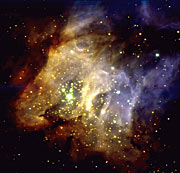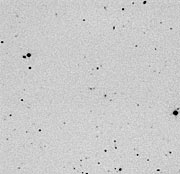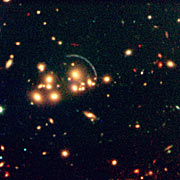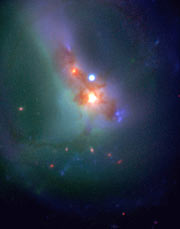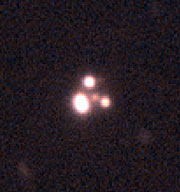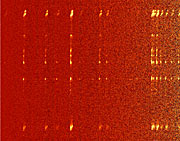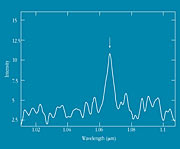Press Release
First Images and Spectra from ISAAC on UT1
New VLT Instrument Delivers Spectacular Infrared Views of the Southern Sky
26 November 1998
The VLT Infrared Spectrometer And Array Camera (ISAAC) [1] was installed at the first 8.2-m VLT Unit Telescope (UT1) on November 14, 1998, cf. ESO PR Photos 42a-h/98. ISAAC is the second major VLT instrument to be installed at the VLT and the first to be fully designed and developed at ESO within its Instrumentation Division.
Following evacuation of its large vacuum vessel, cooling to cryogenic temperature and alignment with the telescope according to the planned schedule, it successfully achieved technical first light during the night between November 16 and 17, 1998.
The first focus tests on stars yielded images of excellent sharpness, around 0.45 arcsec full-width-half-maximum (FWHM). During the following nights, even better images, as small as 0.25 arcsec in relatively short exposures, were obtained, testifying to the quality of the site as well as the optical quality of both the telescope and instrument. Observations were executed using the new VLT Control and Data Flow Systems which are driven by Observation Blocks that define all details of the required astronomical exposures.
In addition to direct images in various infrared colours (selected with different optical filters), spectroscopic observations were also made during the first few nights of operation.
This Press Release is accompanied by several images and spectra which illustrate some of the exceptional new astronomical capabilities offered by this instrument.
Star-Forming Region RCW38 in the Milky Way
eso9856b displays a spectacular three-colour composite image of RCW38 , obtained through three near-infrared filters. This is a region in the Milky Way at a distance of about 5,000 light years, where stars which have recently formed in clouds of gas and dust are still heavily obscured and cannot be observed in the visible part of the spectrum. Contrarily, as this image shows, they are very well seen at infrared wavelengths where the obscuration is substantially lower. The diffuse radiation is a mixture of starlight scattered by the dust and gas in the area, and atomic and molecular hydrogen line emission.
Distant Radio Galaxy MRC0316-257
eso9856c is a Ks (2.16µm) image, centred on the distant radio galaxy MRC0316-257 (redshift z = 3.14). It was obtained primarily to locate other distant galaxies for future spectroscopic observations with ISAAC.
Galaxy Cluster CL2244-02 with Gravitational Arcs
eso9856d is a colour composite image of the galaxy cluster CL2244-02 (redshift z = 0.3 ), combining a 20 min jittered ISAAC Ks (2.16µm) exposure with 15 min V (green-yellow) and R (red) exposures, obtained with the VLT Test Camera at the UT1 Nasmyth focus. In addition to the prominent blue arc, produced by gravitational lensing of a galaxy at redshift z = 2.24 , there are also notable, very red arcs, both closer to the centre and further out. They were only detected in the infrared image and are probably due to lensing of a much more distant galaxy.
Center of Merging Galaxy System ESO202-G23
eso9856e is a colour composite image of the merging galaxy system ESO202-G23 made by combining an ISAAC H (1.65µm) exposure with (blue) and R (red) exposures made with the VLT Test Camera at Nasmyth focus. At least one of the two nuclei is obviously an Active Galaxy Nucleus (AGN) whose partially collimated ultraviolet radiation is exciting the surrounding gas to the North. Also visible is a blue star-forming complex to the South of the centre and a complicated pattern of gas emission due to the combination of arms resulting from the merger, as well as heavy dust extinction. Of additional interest is the arc of very red objects in the lower part of the image which are more distant galaxies.
Lensed Quasar MG0414+0534
eso9856f is an infrared colour composite of the quadruply lensed quasar system MG0414+0534 made by combining 20 min ISAAC J (1.25µm) and Ks (2.16µm) exposures. This complex of images is only about 2 arcsec across. At the centre is the red galaxy at redshift z = 0.96 which is responsible for the four (of which two are not completely resolved) gravitationally lensed images of a z = 2.64 quasar plus a faint arc.
Herbig-Haro Object HH212
eso9856g shows a long-slit (2 arcmin) spectrum in the 2 - 2.5µm spectral region of the Herbig Haro object HH212 . The spectral resolution is about 500. It is believed that a protostar - that is invisible even at infrared wavelengths - is responsible for the two pulsed jets seen in this spectral image. They are remarkable because of the high degree of symmetry of the 'blobs' which have been ejected in opposite directions (up and down in this image). Each of the individual 'images' shows the jets in a different spectral line emitted by molecular hydrogen that has been shock excited by the impact of the ejected gas.
Starforming Galaxy at Redshift 0.62
eso9856h is an infrared spectrum showing the Hydrogen-alpha (0.6563µm) emission line (indicated with an arrow), shifted to 1.06µm in a star-forming galaxy at redshift z = 0.62 , discovered in the CFRS survey. The total integration time with ISAAC was only 1 hour.
Notes
[1] ISAAC is a cryogenic infrared imager and spectrometer (spectral region 0.9 - 5 µm) installed at the Nasmyth B focus of UT1. It has two arms, one for the Short Wavelength (SW) spectral domain (0.9 - 2.5 µm), and one for the Long Wavelength (LW) spectral domain (2.5 - 5 µm), both equipped with state-of-the-art detectors. ISAAC has a variety of imaging and spectroscopy modes in both of the arms. It is controlled via a panoply of software templates for defining and executing sequences of operations for Acquisition, Observation and Calibration. As any other VLT instrument, ISAAC can be used in Service or Visitor Mode.
More information
Technical Information: The photo is a combination of three exposures through Z (centred at 0.90µm), H (1.65µm) and Ks filters (2.16µm) and with exposure times of 160, 320 and 210 seconds, respectively, The field measures 2.5 x 2.5 arcmin with North at the top and East to the left. The seeing was 0.4 arcsec.
About the Release
| Release No.: | eso9856 |
| Legacy ID: | PR 19/98 |
| Name: | CFRS survey, CL2244-02, ESO202-G23, HH 212, ISAAC, MG0414+0534, MRC0316-257, RCW 38, Very Large Telescope |
| Type: | Milky Way : Star : Grouping : Cluster Local Universe : Star : Evolutionary Stage : Young Stellar Object Local Universe : Galaxy : Type : Interacting Early Universe : Galaxy Early Universe : Galaxy : Type : Gravitationally Lensed Early Universe : Galaxy : Activity : AGN : Quasar Early Universe : Galaxy : Grouping : Cluster Early Universe : Cosmology : Morphology : Deep Field Unspecified : Technology : Observatory : Instrument |
| Facility: | Very Large Telescope |
| Instruments: | ISAAC |
Our use of Cookies
We use cookies that are essential for accessing our websites and using our services. We also use cookies to analyse, measure and improve our websites’ performance, to enable content sharing via social media and to display media content hosted on third-party platforms.
ESO Cookies Policy
The European Organisation for Astronomical Research in the Southern Hemisphere (ESO) is the pre-eminent intergovernmental science and technology organisation in astronomy. It carries out an ambitious programme focused on the design, construction and operation of powerful ground-based observing facilities for astronomy.
This Cookies Policy is intended to provide clarity by outlining the cookies used on the ESO public websites, their functions, the options you have for controlling them, and the ways you can contact us for additional details.
What are cookies?
Cookies are small pieces of data stored on your device by websites you visit. They serve various purposes, such as remembering login credentials and preferences and enhance your browsing experience.
Categories of cookies we use
Essential cookies (always active): These cookies are strictly necessary for the proper functioning of our website. Without these cookies, the website cannot operate correctly, and certain services, such as logging in or accessing secure areas, may not be available; because they are essential for the website’s operation, they cannot be disabled.
Functional Cookies: These cookies enhance your browsing experience by enabling additional features and personalization, such as remembering your preferences and settings. While not strictly necessary for the website to function, they improve usability and convenience; these cookies are only placed if you provide your consent.
Analytics cookies: These cookies collect information about how visitors interact with our website, such as which pages are visited most often and how users navigate the site. This data helps us improve website performance, optimize content, and enhance the user experience; these cookies are only placed if you provide your consent. We use the following analytics cookies.
Matomo Cookies:
This website uses Matomo (formerly Piwik), an open source software which enables the statistical analysis of website visits. Matomo uses cookies (text files) which are saved on your computer and which allow us to analyze how you use our website. The website user information generated by the cookies will only be saved on the servers of our IT Department. We use this information to analyze www.eso.org visits and to prepare reports on website activities. These data will not be disclosed to third parties.
On behalf of ESO, Matomo will use this information for the purpose of evaluating your use of the website, compiling reports on website activity and providing other services relating to website activity and internet usage.
Matomo cookies settings:
Additional Third-party cookies on ESO websites: some of our pages display content from external providers, e.g. YouTube.
Such third-party services are outside of ESO control and may, at any time, change their terms of service, use of cookies, etc.
YouTube: Some videos on the ESO website are embedded from ESO’s official YouTube channel. We have enabled YouTube’s privacy-enhanced mode, meaning that no cookies are set unless the user actively clicks on the video to play it. Additionally, in this mode, YouTube does not store any personally identifiable cookie data for embedded video playbacks. For more details, please refer to YouTube’s embedding videos information page.
Cookies can also be classified based on the following elements.
Regarding the domain, there are:
- First-party cookies, set by the website you are currently visiting. They are stored by the same domain that you are browsing and are used to enhance your experience on that site;
- Third-party cookies, set by a domain other than the one you are currently visiting.
As for their duration, cookies can be:
- Browser-session cookies, which are deleted when the user closes the browser;
- Stored cookies, which stay on the user's device for a predetermined period of time.
How to manage cookies
Cookie settings: You can modify your cookie choices for the ESO webpages at any time by clicking on the link Cookie settings at the bottom of any page.
In your browser: If you wish to delete cookies or instruct your browser to delete or block cookies by default, please visit the help pages of your browser:
Please be aware that if you delete or decline cookies, certain functionalities of our website may be not be available and your browsing experience may be affected.
You can set most browsers to prevent any cookies being placed on your device, but you may then have to manually adjust some preferences every time you visit a site/page. And some services and functionalities may not work properly at all (e.g. profile logging-in, shop check out).
Updates to the ESO Cookies Policy
The ESO Cookies Policy may be subject to future updates, which will be made available on this page.
Additional information
For any queries related to cookies, please contact: pdprATesoDOTorg.
As ESO public webpages are managed by our Department of Communication, your questions will be dealt with the support of the said Department.


